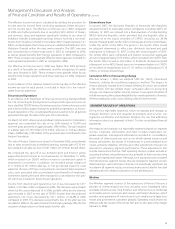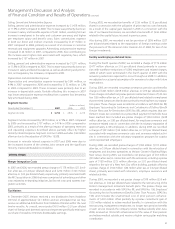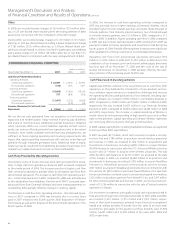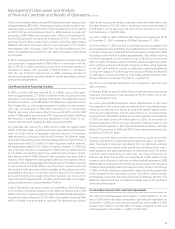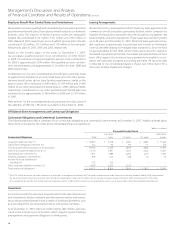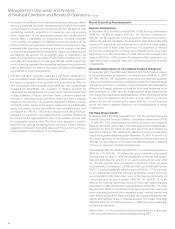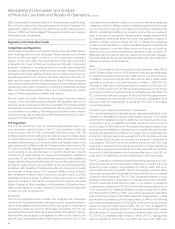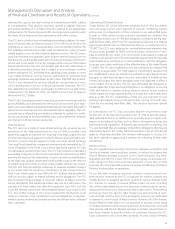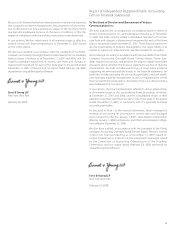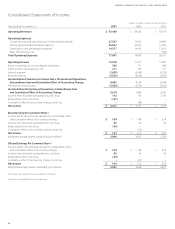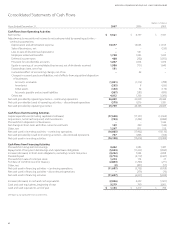Verizon Wireless 2007 Annual Report Download - page 34
Download and view the complete annual report
Please find page 34 of the 2007 Verizon Wireless annual report below. You can navigate through the pages in the report by either clicking on the pages listed below, or by using the keyword search tool below to find specific information within the annual report.
Recent Accounting Pronouncements
Business Combinations
InDecember2007,theFASBissuedSFASNo.141(R),Business Combinations
(SFAS No. 141(R)), to replace SFAS No. 141, Business Combinations.
SFASNo.141(R)requiresuseoftheacquisitionmethodofaccounting,
defines the acquirer, establishes the acquisition date and broadens the
scope to all transactions and other events in which one entity obtains
control over one or more other businesses. This statement is effective
for business combinations or transactions entered into for fiscal years
beginning on or after December 15, 2008. We are still evaluating the
impactofSFASNo.141(R),however,theadoptionofthisstatementisnot
expected to have a material impact on our financial position or results
of operations.
Noncontrolling Interests in Consolidated Financial Statements
In December 2007, the FASB issued SFAS No. 160, Noncontrolling Interests
in Consolidated Financial Statements – an amendment of ARB No. 51, (SFAS
No. 160). SFAS No. 160 establishes accounting and reporting standards
for the noncontrolling interest in a subsidiary and for the retained interest
and gain or loss when a subsidiary is deconsolidated. This statement is
effective for financial statements issued for fiscal years beginning on or
after December 15, 2008. Upon the initial adoption of this statement we
will change the classification and presentation of Noncontrolling Interest
in our financial statements, which we currently refer to as minority
interest. We are still evaluating the impact SFAS No. 160 will have, but
we do not expect a material impact on our financial position or results
of operations.
Fair Value Measurements
In February 2007, the FASB issued SFAS No. 159, The Fair Value Option for
Financial Assets and Financial Liabilities - Including an Amendment of SFAS
115 (SFAS No. 159), which permits but does not require us to measure
financial instruments and certain other items at fair value. Unrealized gains
and losses on items for which the fair value option has been elected are
reported in earnings. This statement is effective for financial statements
issued for fiscal years beginning after November 15, 2007. As we will not
elect to fair value any of our financial instruments under the provisions of
SFAS No. 159, the adoption of this statement effective January 1, 2008 will
not have an impact on our financial statements.
In September 2006, the FASB issued SFAS No. 157, Fair Value Measurement
(SFAS No. 157). SFAS No. 157 defines fair value, establishes a framework
for measuring fair value in GAAP and establishes a hierarchy that catego-
rizes and prioritizes the sources to be used to estimate fair value. SFAS
No. 157 also expands financial statement disclosures about fair value
measurements. On February 12, 2008, the FASB issued FASB Staff Position
(FSP) 157-2 which delays the effective date of SFAS No. 157 for one year,
for all nonfinancial assets and nonfinancial liabilities, except those that
are recognized or disclosed at fair value in the financial statements on
a recurring basis (at least annually). SFAS No. 157 and FSP 157-2 are
effective for financial statements issued for fiscal years beginning after
November 15, 2007. We will elect a partial deferral of SFAS No. 157 under
the provisions of FSP 157-2 related to the measurement of fair value used
when evaluating goodwill, other intangible assets, wireless licenses and
other long-lived assets for impairment and valuing asset retirement obli-
gations and liabilities for exit or disposal activities. The impact of partially
adopting SFAS No. 157 effective January 1, 2008 will not be material to
our financial statements.
RefertoNote1intheconsolidatedfinancialstatementsforadiscussion
of the accounting pronouncements adopted during 2007.
• Our current and deferred income taxes, and associated valuation allow-
ances, are impacted by events and transactions arising in the normal
course of business as well as in connection with the adoption of new
accounting standards, acquisitions of businesses and non-recurring
items. Assessment of the appropriate amount and classification of
income taxes is dependent on several factors, including estimates
of the timing and realization of deferred income tax assets and the
timing of income tax payments. Actual collections and payments may
materially differ from these estimates as a result of changes in tax laws
as well as unanticipated future transactions impacting related income
tax balances. We account for tax benefits taken or expected to be
taken in our tax returns in accordance with FASB Interpretation No. 48,
Accounting for Uncertainty in Income Taxes (FIN 48), which requires the
use of a two-step approach for recognizing and measuring tax benefits
taken or expected to be taken in a tax return and disclosures regarding
uncertainties in income tax positions.
• Goodwill and other intangible assets are a significant component of
our consolidated assets. Wireline goodwill of $4,900 million represents
the largest component of our goodwill and, as required by SFAS No.
142, Goodwill and Other Intangible Assets (SFAS No. 142), is periodically
evaluated for impairment. The evaluation of Wireline goodwill for
impairment is primarily based on a discounted cash flow model that
includes estimates of future cash flows. There is inherent subjectivity
involved in estimating future cash flows, which can have a material
impact on the amount of any potential impairment. Wireless licenses
of $50,796 million represent the largest component of our intangible
assets. Our wireless licenses are indefinite-lived intangible assets, and
as required by SFAS No. 142, are not amortized but are periodically
evaluated for impairment. Any impairment loss would be determined
by comparing the aggregated fair value of the wireless licenses with
the aggregated carrying value. The direct value approach is used to
determine fair value by estimating future cash flows. There is inherent
subjectivity involved in estimating future cash flows, which can have a
material impact on the amount of any impairment.
32
Management’s Discussion and Analysis
ofFinancialConditionandResultsofOperations continued



